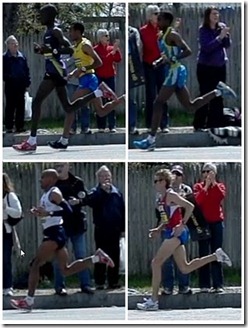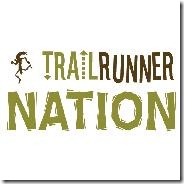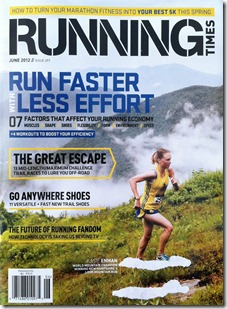 I was originally planning to publish a few excerpts from my book, Tread Lightly: Form, Footwear, and the Quest for Injury-Free Running, prior to its June 1 release date. Well, the publisher moved faster than I expected, and the book is now in-stock at Amazon.com and should be on store shelves very soon (and yes, a Kindle edition is also in the works from what I have been told).
I was originally planning to publish a few excerpts from my book, Tread Lightly: Form, Footwear, and the Quest for Injury-Free Running, prior to its June 1 release date. Well, the publisher moved faster than I expected, and the book is now in-stock at Amazon.com and should be on store shelves very soon (and yes, a Kindle edition is also in the works from what I have been told).
Despite this, I’ve decided to move on with publishing a few excerpts, and below is the first. The text is a sidebar from a chapter on the running stride titled “Should You Attempt to Run Like the Elites?” It discusses why caution is warranted when examining the running form of an elite runner and trying to apply it to yourself. Enjoy!
Should You Attempt to Run Like the Elites?
One approach to learning about good running form is to watch the elites – they run for a living and have spent more time fine-tuning their form than the vast majority of recreational runners. However, a few things should be kept in mind when trying to emulate the form of elite runners.
First, and most obviously, elite runners in a race are running very fast, and form changes with speed. It makes little sense for a recreational runner who puts in most of their miles at an 8:00 or 9:00 per mile pace to attempt to perfectly mimic the gait of an elite 10,000-meter specialist running at a sub-5:00 per mile pace. Most of us would be better off emulating the relaxed form they employ during their victory lap!
Second, form among elite runners is variable. Alberto Salazar, who won the Boston Marathon once and New York City Marathon three times in the early 1980’s, was widely believed to have succeeded despite his form rather than because of it. So even elites may not be perfect role models. Should the average runner mimic the head-bob of Paula Radcliffe? Probably not, even though she does happen to own the women’s marathon world record. Emil Zatopek was one of the greatest distance runners of all time. But here’s how New York Herald Tribune sports columnist Red Smith described his form: “He ran like a man with a noose around his neck…the most frightful horror spectacle since Frankenstein…on the verge of strangulation; his hatchet face was crimson; his tongue lolled out.” Another newspaper scribe wrote, “He ran as if his next step would be his last.” But Zatopek, a three-time gold medalist in the 1952 Helsinki Olympics, had a ready-made answer for his critics: “I shall learn to have a better style once they start judging races according to their beauty. So long as it’s a question of speed then my attention will be directed to seeing how fast I can cover the ground.”
There are many factors that make elites capable of throwing down times that the rest of us could only dream of – these include inherent aspects of their anatomy and physiology, training background, motivation, mental toughness, VO2 max, capacity to endure pain, and so on. Form is just one part of the picture when it comes to elite running success, and it may be a very small part.
Taking this a step further, even if we take a group of elites who experts might classify as having “ideal” form, careful examination will reveal variation among them. Some carry their arms high, some carry them low. Some keep their torso upright, some lean forward a bit. Some spend a bit more time with both feet airborne, some stay closer to the ground. Some heel strike, some land on the midfoot, and others land on the forefoot. There are commonalities among elites that may suggest general patterns, but looking at any single elite’s running form as a model of absolute perfection that should be copied is a mistake. Running biomechanist Peter Cavanagh made this very point back in 1980 in the book The Sweet Spot in Time by John Jerome: “It doesn’t work, for instance, to tell the novice to imitate (Bill) Rodgers…running style, or performance in any sport, eventually boils down to the way you adapt to your own anatomy, your own physiology, to the peculiarities of your own body.”
The take-away message for all runners is that each of us is unique—and this applies to the recreational runner as well as the elite. Ultimately, the key is finding the best form for your individual body – whether that’s the form that lets you run fastest, most efficiently, or with least chance of injury, that decision is up to you.

















Is your book going to be available in the UK?
Whenever someone uses Olympians and World Champions for comparison (e.g. “Olypmic runners wear shoes!”), I respond: You can compare yourself to them as soon as you’re a 5’4″ 150 pound guy running almost 13 miles an hour for 2 hours. Until then, WHO CARES what he’s doing?!
Amazon confirmed my shipment for May 16th. Very excited to read the book! Hoping for the inspiration to go for my third marathon sometime this year.
This piece confirms my own experience. As both an above and below average distance runner (84min half marathon PB to 4:45 marathon on occasion), I have experienced major differences in running style. If you run 4:20 min/km (roughly 3h marathon), you definitely run more on the front of your feet than when you are plodding along at 7 min/km. For a jogger running on the front of your feet are simply biomechanically incorrect.
As a South African, your comments on odd running form of elite runners made me think of two excellent examples:
Vladimir Kotov, with his toe-up shuffle and almost no knee bending (it seems), is famous for his extremely long competitive career. He came fourth in the 1980 Olympic marathon and still won the 90km Comrades marathon three times (one record) in the early 2000s. In 2010 he still made 13th place at age 52! (See Wikipedia).
Matthews “Loop-en-Val” Motshwarateu’s nick name literally means “Run-and-Fall”. He was a South African champion and record holder in long distance track and cross country and was dominant in the same events in the US on a scholarship at UTEP. His success included the 10km world record in New York in 1980. Read a moving piece about his glory years and sad passing here: link to southafrica.info…
Thanks for tip of book!
Pete, I agree. As someone who runs for the enjoyment of it the running form of elites has little relevance for me. For ‘perfect’ running form I look no further than my five year old who runs beautifully. I would love to be able to run like he does and I hope he can maintain that form into adulthood. Cheers, Paul
There are many factors that make elites capable of throwing down times
that the rest of us could only dream of – these include inherent aspects
of their anatomy and physiology, training background, motivation,
mental toughness, VO2 max, capacity to endure pain, and so
on. Form is just one part of the picture when it comes to elite running
success, and it may be a very small part.
Pete,
A great post as always and I look forward to reading the entire book. Your make great points. I would only add one — even elite runners who are said to have admirable form get injured. I often read message board threads in which well-meaning runners suggest we should run like Kenesia Bekele, Haile Gebrselassie, Ryan Hall, etc., suggesting that if we do then we won’t get injured. What gets missed is that Bekele sat out the 2010 season with various injuries; Gebrselassie has had knee problems (often assumed to be the province of heel-strikers) late in his career, causing him to drop out of NYC Marathon in 2010; and Ryan Hall has had a widely-publicized battle with plantar faciitis recently. Though all of these runners have either returned from their injuries or weren’t entirely sidelined from them (Hall), others, like Martin Lel, have pretty much fallen off of the map because of their ailments. Modeling our form after that of elite runners may sometimes be worthwhile, and in some cases even reduce the chance of certain injures, but if you run hard enough and long enough, you will probably eventually get injured. Aaron
I agree, there are no magic bullets when it comes to injuries. With elites you do have to keep in mind their training volume and the speed they are running at, which certainly adds to the stress on their bodies, but I think each person needs to find the best form for their own body and circumstances and not emulate what someone else is doing.
Pete
—-
Pete Larson’s Web Links:
My book: Tread Lightly – Form Footwear and the Quest For Injury Free Running<http: 1616083743=”” gp=”” product=”” ref=”as_li_ss_tl?ie=UTF8&tag=thviofli-20&linkCode=as2&camp=1789&creative=390957&creativeASIN=1616083743″ http://www.amazon.com=“”> Work: link to anselm.edu…
Blog: https://runblogger.com
Dailymile Profile: link to dailymile.com…
Twitter: link to twitter.com</http:>
Your book showed up from Amazon yesterday – as always, well done, Pete!
Thanks Kent! Would love to hear what you think.
Pete
—-
Pete Larson’s Web Links:
My book: Tread Lightly – Form Footwear and the Quest For Injury Free Running<http: 1616083743=”” gp=”” product=”” ref=”as_li_ss_tl?ie=UTF8&tag=thviofli-20&linkCode=as2&camp=1789&creative=390957&creativeASIN=1616083743″ http://www.amazon.com=“”> Work: link to anselm.edu…
Blog: https://runblogger.com
Dailymile Profile: link to dailymile.com…
Twitter: link to twitter.com</http:>
Will do- I always keep up with your blog posts but haven’t had much time to write lately. Busy with work (joined a new practice so more injured runners to work with), along with training and such. Wear-testing for NB continues – very interesting shoes on the horizon!
I completely agree that tempo has a great deal to do with not only form, but optimal shoes as well. Pete you’ve commented that you spend all your non running life in zero drop foot ware. I’d extend this to say you should spend all your 8+ minute mile life in zero drop.
It only makes sense that as your tempo increases, so does your forward lean. Increased forward lean creates additional tension in the achilles, soleus and vastus, as the runner struggles with the dorsiflex required to relax the calf and put weight on the heel throughout the contact stage. I believe this is why you see elite marathon runners continuing to wear shoes with 4-8mm heels in most cases. It also explains ultra runners increasingly being drawn to zero drop, as their pace, and thus forward lean is less than that of a marathon runner.
The premise that humans evolved as a race of persistence hunters and walkers is also supportive of this theory. We weren’t designed to run 13 miles an hour for two hours, and we’re pushing our bodies to the utter limit to accomplish that feat. There may be nothing wrong with allowing technology (cushion and a little heel lift) to aid us in this endeavor. We very well may have been designed to run eight minute miles for five hours bare foot, with sandals or moccasins being utilized at some point along the way.
The bigger issue I think is that speed increases forces, and those need to be dealt with. The lean might be art of it, but a lot of elites I ave filmed run stark upright.
Sent from my iPad
link to youtube.com…
A form worth emulating (see 1:30 and after). And in heels (without necessarily heel striking)!
Awesome!
Pete
—-
Pete Larson’s Web Links:
My book: Tread Lightly – Form Footwear and the Quest For Injury Free Running<http: 1616083743=”” gp=”” product=”” ref=”as_li_ss_tl?ie=UTF8&tag=thviofli-20&linkCode=as2&camp=1789&creative=390957&creativeASIN=1616083743″ http://www.amazon.com=“”> Work: link to anselm.edu…
Blog: https://runblogger.com
Dailymile Profile: link to dailymile.com…
Twitter: link to twitter.com</http:>